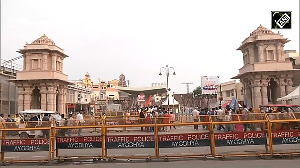India Inc is on a roll. Corporations are restructuring, cutting flab, improving productivity and even planning fresh investments. Financial intermediaries are reinventing themselves.
With companies no longer raising money from banks, non-banking companies and financial institutions are increasingly focusing on trading government securities, fee-based businesses and other advisory services.
Individuals (call them consumers or borrowers, depending on where you stand) -- the third arm of the triangle of the Discover India story -- are also repositioning their aspirations. Over the past one year people in urban India have been making a 180-degree shift in their spending pattern, focusing on only revenue expenditure, after having dumped capital expenditure.
They are buying flats without making a capital expenditure of Rs 20 lakh (Rs 2 million). Instead, they are spending Rs 14,000 or so every month for the next 20 years. They are buying cars but not spending Rs 700,000 at one go.
Instead, they are paying a few thousand rupees every month. This also applies to buying two-wheelers, computers and white goods like TV and refrigerators, mobile phones and even holidaying abroad.
The mechanism that has triggered the radical change in the balance-sheet of an urban Indian is the EMI, or equated monthly instalments. Banks and non-banking companies are tailoring EMIs to suit consumers.
They can follow a step-up structure (where EMIs can be low in the beginning and gradually increase as the consumer's spending power goes up); a step-down structure (opposite of step-up); and even a balloon repayment option (an unusually high payment at one go when the consumer has a funds inflow on account of maturity of an insurance policy or through inheritance).
Both, companies (such as dealers of cars and two-wheelers) and financial intermediaries are joining hands to structure the EMIs in such a way that the capital cost (the actual cost of the good) is fast becoming irrelevant.
For instance, a two-wheeler manufacturer knows that the cost of one particular brand -- whether Rs 39,000 or Rs 41,000 -- is irrelevant. What is relevant is whether the EMI is Rs 990 or Rs 1,050. If the EMI is kept in three figures, the consumer will buy the model as his revenue expenditure or the monthly outgo is well within his budget.
Devising EMIs to suit customers' needs is only one aspect of commercial banks' new-found passion for retail lending. They are on overdrive pushing all possible products in this segment.
For instance, Citibank is flooding its Suvidha customers with overdraft facilities. Suvidha is a special banking platform for the masses where customers are discouraged to visit branches. They operate their accounts through other channels like ATMs and over the telephone. Whether a customer wants it or not, a certain amount of money is kept in his account and he is charged only if he uses the money.
American Express, State Bank of India and others are also willing to woo existing credit card customers of other banks by cutting interest rates. What's more, SBI has even declared a payment holiday for its credit card customers who do not need to pay even the minimum amount due on their credit card spending this Christmas.
As if all this is not enough, Standard Chartered and ICICI Bank have gone one step ahead and changed the look of their credit cards. They are now smaller and look smarter.
The net result of all these strategies? The retail assets of banks are growing at a phenomenal speed. Over 80 per cent of the incremental growth in the banking sector is on account of retail lending. SBI, which normally depends on the manufacturing sector for building assets, now launches at least one product every month and plans to make retail account for 50 per cent of its balance-sheet.
Roughly 80 per cent of the incremental retail loans are coming from the housing sector. The credit card business is also thriving. Over the past one year, there has been a 100 per cent growth in the volume of transactions put through credit cards.
The number of new card holders (those who did not own a card before) is growing and at the same time a lot of existing card holders are upgrading from one card to two and even three cards.
In the personal loans segment, loans against shares are growing with the stock markets on a roll. Even to participate in initial public offerings, individuals are drawing bank money. Banks poured in money in all the recent IPOs -- from Maruti Udyog to Uco Bank and Indraprastha Gas.
So far, so good. But some of the bankers have started smelling a rat in the consumer spending story. Oriental Bank of Commerce Chairman and Managing Director B D Narang says the incremental non-performing assets in the home loan sector is about 2.5 per cent and the overall NPA level in this segment could be around 1.5 per cent.
This is shocking because the general impression is that home loan NPA level is within the 1 per cent limit. What's more, Narang also bursts the myth of the security of home loans. He feels that home loans are as good as clean (unsecured) loans because in most of the cases the documentation is faulty and the lenders cannot claim any rights on the property mortgaged to it.
The bad news does not end here. Another senior foreign banker says the default rates in credit cards are rising fast. Moreover, a significant number of credit card users is using the piece of plastic for cash withdrawal and not for buying goods.
Of course, there is a contrarian view to these arguments. The credit-to-GDP ratio in India is still minuscule compared with China, Singapore, Korea and other south-east Asian countries. Consumer financing is only about 3 per cent of our GDP while in Korea it is 21 per cent.
Similarly, mortgages account for 2 per cent of our GDP. The comparable figure in China is 6 per cent and Singapore 68 per cent. As far as personal finance is concerned, again in India it is about 2 per cent of GDP and the comparable figure in Korea is 120 per cent and Singapore 20 per cent.
HDFC Bank Managing Director Aditya Puri feels these loans -- granular in nature -- are safe. One big corporate account can take the bottom out of a bank's balance-sheet if it goes bad but it will take lakhs of personal loan accounts to do the same damage to a bank's balance-sheet.
It may be unfair to ring the alarm bell at this moment and describe the retail asset creation as a bubble. But the fact remains that banks are on an overdrive to create retail assets and at least some of them do not have their checks and balances in place.
Strangely, most of the banks are following the cardinal rule of know your customer only while building liabilities and not assets. A branch manager questions the source of money when an individual wants to put in Rs 50,000 in his bank account but often a credit card is issued without knowing the customer.
Ditto for a new flat owner. The direct sales agents who are instrumental in the creation of these assets for financial intermediaries are seldom alert on KYC rules.
Why are the banks pushing too hard on the retail front? They are doing so to respond to competition. They are also showing signs of complacency as the net NPA level of the industry is dropping by the day. The official NPA figure of China's banking industry is 26 per cent but unofficially it could be higher than 40 per cent.
Banks in east Asian countries have NPAs between 10 and 15 per cent. In India, the net NPA now veers around 7 to 8 per cent. NPAs may raise their ugly heads again if banks fail to set their house in order before taking the plunge in the retail game.






 © 2025
© 2025